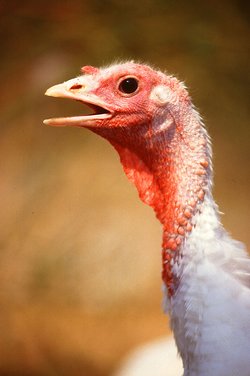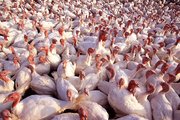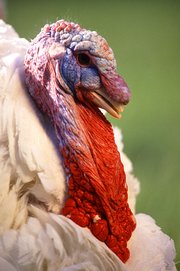Domesticated turkey
|
|
| Domesticated turkey | ||||||||||||
|---|---|---|---|---|---|---|---|---|---|---|---|---|
 Large White Turkey | ||||||||||||
| Scientific classification | ||||||||||||
| ||||||||||||
| {{Species | ||||||||||||
| }}
Meleagris gallopavo |
| Contents |
Domesticated Turkeys are large poultry birds raised for food. Turkeys are traditionally eaten as the main course of large feasts at Christmas in Europe and North America, as well as Thanksgiving in the United States and Canada, in both cases having displaced the traditional goose. While eating turkey was once mainly restricted to special occasions such as these, turkey is now eaten year round and forms a regular part of many diets.
Despite the name, turkeys do not come from the country of Turkey and are instead native to North America. English is not the only language to make this allusion, however - see the main article on turkeys.
The domesticated turkey is descended from the North American Wild Turkey, Meleagris gallopavo. The Aztecs domesticated the southern Mexican form, M. g. gallopavo, one of six subspecies.
The turkey is reared throughout temperate parts of the World, and is a popular form of poultry because industrialised farming has made it very cheap for the amount of meat it produces.
In the USA, the female domesticated turkey is referred to as a hen, a male as a tom, a chick as a poult and a castrated turkey as a hokie. In Europe, the male is a stag.
The great majority of domesticated turkeys have white feathers, although brown or bronze-feathered varieties are also raised.
History
Suggestions have been made that the Mexican Ocellated Turkey (Meleagris ocellata) might also be involved, but the plumage of domestic turkeys does not support this theory; in particular, the chest tuft of domestic turkeys is a clear indicator of descent from the Wild Turkey (the Ocellated Turkey does not have this tuft).
Breeding
Modern breeds of turkey are too large to breed naturally, so they are usually bred using artificial insemination. However, turkey hens are often able to produce young from unfertilized eggs in a process called parthenogenesis.
Availability
Prior to World War II, turkey was something of a luxury in Britain, with goose or beef a more common Christmas dinner [1] (http://www.findarticles.com/p/articles/mi_m1373/is_12_51/ai_81764498/pg_2) (In Charles Dickens' A Christmas Carol Bob Cratchit had a goose before Scrooge bought him a turkey). Intensive farming of turkeys from the late 1940s, however, dramatically cut the price and it became far and away the most common Christmas dinner meat. Leftovers are generally served as cold cuts on Boxing Day.
Butchering
Jean-Baptiste_Siméon_Chardin_027.jpg
To kill a live turkey, withhold food for a day to help ensure the digestive system is empty. Putting the turkey in a bag, with one corner cut out for the head, helps keep the turkey from thrashing and damaging itself or the people involved in preparing it. One method is to hammer two nails into a stump and bend them, then put the turkey's head on the stump and turn the nails to hold the turkey's head still, then remove the turkey's head with an axe. The turkey will thrash for a few moments. Hang it upside down to bleed for a half hour or so. Then pluck it. Smaller feathers can be pulled off in a bunch; larger feathers need to be removed one at a time so as not to tear the skin. Stubborn feathers can be pulled with pliers or a forceps. When all the feathers are removed, rinse the turkey's anus to remove any residue, then insert a sharp knife just below the hip bone, but not so deep as to puncture any of the internal organs. Cut down and around on either side of the anus, making sure it's angled up to keep any excretion off the meat. Carefully pull out and discard. Then reach inside the turkey and remove all organs, as well as large globs of fat. If desired, the heart, liver (slice away from other innards, being careful not to puncture the green gall), and gizzard can be saved for giblets. If the gizzard is saved, slice it in half until the gravel inside grates against the knife, then slice around and open up, peeling away the inner layer and discarding the contents. After all the organs have been removed, turn the turkey around and cut around the circumference of the neck and peel down, exposing the esophogus and windpipe. For each, separate them from their attachment points and pull them out, including the crop in the case of the esophogus. Rinse the turkey out with cold water and, if desired, hang and chill for a day or so before freezing.
Turkeys as food
In countries where turkey is popular, it is available commonly in supermarkets. Turkeys are sold "whole" in a manner similar to chicken with the head, feet, and feathers removed, as well as sliced and ground. Sliced Turkey is frequently used as a sandwich meat or served as cold cuts. Ground turkey is sold just as ground beef, and is sometimes used as a healthy beef substitute. Without proper preparation, turkey is usually considered to end up less moist than, say, chicken or duck.
Wild turkeys, while technically the same species as domesticated turkeys, have a very different taste from farm-raised turkeys. Almost all of the meat is "dark" (even the breasts) with a more intense turkey flavor.
Cooking
Template:Cookbookpar Both fresh and frozen turkeys are used for cooking; as with most foods, fresh turkeys are generally preferred, although they cost more. Around holiday seasons, high demand for fresh turkeys often makes them difficult to purchase without ordering in advance. However, the large size of the turkeys typically used for consumption makes defrosting them a major endeavor: a typically-sized turkey will take several days to properly defrost.
Turkeys are usually baked or roasted in an oven for several hours, often while the cook prepares the rest of the meal. Sometimes, a turkey is brined before baking to enhance flavor and moisture content. In some areas, particularly the American South, they may also be deep fried in hot oil (often peanut oil) for 30 to 45 minutes by using a turkey fryer. Deep frying turkey has become something of a fad, with hazardous consequences for those unprepared to safely handle the large quantities of hot oil required. [2] (http://www.ul.com/consumers/turkeys.html)
Accompaniments
For Christmas in Britain, turkey is traditionally served with winter vegetables including roast potatoes, Brussels sprouts, and parsnips. Cranberry sauce is the traditional condiment in the northern rural areas of Britain where wild cranberries grow. In the south and in urban areas, where cranberries until recently were difficult to obtain, bread sauce was used in its place, but the availability of commercial cranberry sauce has seen a rise in its popularity in these areas too. Sometimes sausagemeat, cocktail sausages or liver wrapped in bacon is also served (known as bacon rolls or "pigs in blankets").
Especially during holiday seasons, stuffing is traditionally served with turkey. There are many varieties: oatmeal, chestnut, sage and onion (flavoured bread), and sausage (possibly with mashed potato) are the most traditional. Stuffing may either be used to stuff the turkey (as the name implies), or may be cooked separately and served as a side dish.
For Thanksgiving in the United States, turkey is traditionally served with cranberry sauce and gravy. Other items vary, but common complementary dishes include mashed potatoes, dinner rolls, various vegetables such as corn, squash, sweet potatoes, and various types of pies for dessert (such as pumpkin, apple and pecan).
Health concerns
Turkey is generally considered healthier and less fattening than red meat. Turkey is high in tryptophan, and is commonly credited with causing sleepiness after a meal, however this is largely a misconception. Turkey dinners are commonly large meals served with carbohydrates, fats, and alcohol in a relaxed atmosphere, all of which are bigger contributors to post-meal sleepiness than the tryptophan in turkey. Template:Sect-stub
See also
- Turkey (bird) - the main article on turkeys.
- Turducken - a turkey prepared with duck and chicken.
- Turkey fryer - a device for deep frying turkey.
References
External links
- Some more information on turkeys (http://birds.cornell.edu/programs/AllAboutBirds/BirdGuide/Wild_Turkey.html)
- Thanksgiving turkey recipes from AllRecipes.com (http://thanksgiving.allrecipes.com/directory/2671.asp)
- World Famous Recipes - Turkey Recipes (http://www.worldfamousrecipes.com/turkey-recipes.html)zh:火雞de:Truthahn



